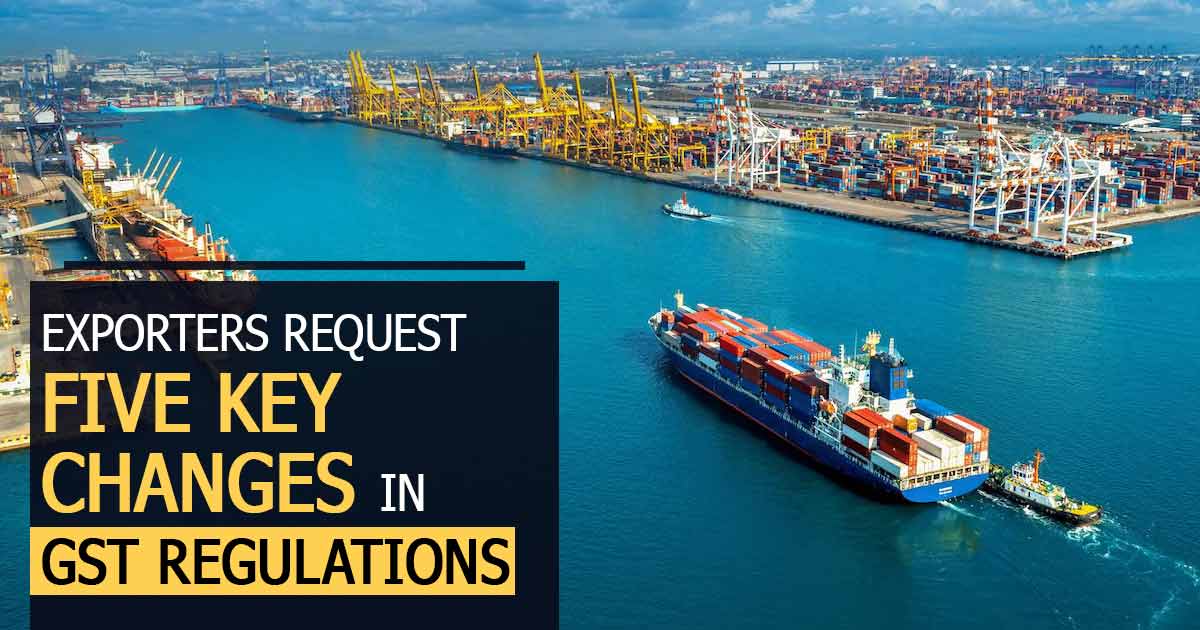
Tax experts advise five key implementations in GST regulations amid India’s merchandise exports facing a decrease for the last five consecutive months. The aim behind these modifications is to give relief to exporters so they can do better in global competitiveness.
Exporters Want 5 Important Key Changes in GST Regulations
- Amendment in Rule 96B of CGST Rules
- Valuation of deemed supply services and
- Clarity on the recipient of remittance service in foreign trade
- Clarity on input tax credit facility under TR-6 Challan
- Clarity on GST liability on shipment of samples.
Nirav Sanjay Karia, Partner & Advocate, Lakshmikumaran & Sridharan Attorneys, gave a statement saying, that the ongoing decline in merchandise exports is happening as a consequence of decreasing demand at the global level and the ongoing war between Russia and Ukraine (resulted in increased inflation, global monetary restrictions, and recession), still, the Indian government is ready to back the exporter community by addressing existing gaps or ambiguity in the relevant GST regulations for export shipments.
For example, as the price negotiations or deficiency in goods are facing barriers from GST liability, exporters are releasing financial credit notes. Therefore, in order to provide some relief to these exporters, Rule 96B of the CGST Rules (which provides for surrender of refund to the extent of non-realization of export proceeds) can be amended. For example, the amount of IGST that is surrendered due to the issuance of a financial credit note can be re-credited.
He gave that statement during his speech at a webinar conducted by MVIRDC World Trade Center Mumbai.
Further, he notified that the government may make it clear if the Indian exporters fall under the category to pay GST on reverse charge mechanism(RCM) when the overseas bank deducts bank charges in instances where foreign buyer cancels sales proceeds to the Indian exporter.
The exporter is not the contractual recipient of the service of the foreign buyer’s bank when the bank of the foreign buyer makes payment through the Authorized Dealer Bank of the Indian exporter. As a result, there is no established legal position because conflicting judicial decisions have been made on who is the service recipient—the Indian exporter, the approved Dealer bank, or the overseas customer. As a result, the Government may explain who is the service beneficiary in this case, he said.
What Did the Indian Government Clarify for Exporters?
The government should clarify whether exporters can claim input tax credits against payment of Integrated Goods & Services Tax (IGST) through TR-6 Challan for import of input materials, recommended Chaitanya Ramesh Bhatt, Partner & Advocate, Lakshmikumaran & Sridharan Attorneys. Under Rule 96(10) of CGST, several export-oriented units (EoUs) and exporters who imported input materials under licenses requiring advance authorization have been prohibited from demanding refunds for IGST on their exports. The government might provide support to exporters, he stated in a statement.
Additionally, he questioned the ambiguity that exporters experience as a result of the invoices’ division into Input Service Distributor (ISD) and Cross Charge sections. In view of that, he claimed that the 50th GST Council mentioned in its meeting that it will provide adequate clarification about ISD and cross-charge.
He added that exporters must pay IGST on the reverse charge mechanism even for supplies made between related individuals without consideration, according to Schedule I of the CGST Act. For instance, even when there is no royalty paid from the former to the latter, it is still considered a presumed supply if an Indian subsidiary uses the brand name of its overseas parent business. As there is no transaction of money between the parties, figuring out the cost or value of this supply is a hurdle.
Read Also: All About GST Export Invoice with Types and Documents
Tax professionals also recommended that the government clarify the issue of GST liability on the shipment of sample goods to foreign parties (related or unconnected) or the shipment of sample goods overseas for quality testing, R&D, and other purposes.
It had been addressed before by Kalantri that in streamlining the GST process, India has done well. This massive progress has been achieved within six years. For other countries, it may still take up to 10 years to implement a well-functioning value-added tax system. At the same time, the government needs to address several unfinished modifications agenda to achieve its prime intention which was One Nation, One Tax.
He recommended that the government can ease the process if it reduces the multiple tax slabs to two and lowers the rates wherever needed. Tax revenue and compliance both can be enhanced by lowering the tax rate. The number of goods has been reduced from 227 in 2017 to 37 at present which was under a 28% tax slab. This highest tax slab rate goods can still be decreased in numbers.
Including petroleum products under the ambit of GST was also recommended.
Exporters from the manufacturing and services industries attended the webinar. They asked many queries regarding GST procedures and issues about the same and their input suppliers.